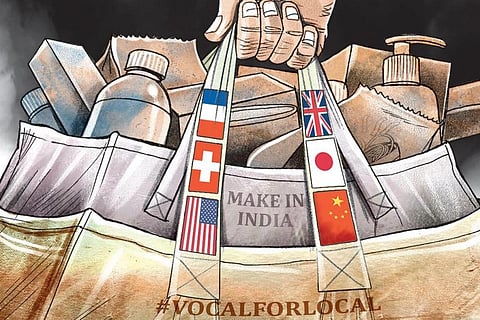

Blue Ocean Strategy can give India a competitive edge and help it connect better with the rest of the world. Such an approach suggests that business firms should stop getting into cut-throat competition and price wars while selling ‘me-too’ products in a cluttered market. There is no point for companies to stay put in a red ocean and see all the bloodshed by different players in an existing market or segment. Instead, they should explore newer opportunities with new businesses and product ideas, thereby creating a new market segment and new demand—and probably entry barriers—so that they enjoy market dominance, mindshare and higher profitability.
Can India adopt a Blue Ocean Strategy and apply it to its Atmanirbhar policy? The idea of self-reliance is good. However, it should not be restricted to the thought of reducing India’s economic dependence on China or boycotting their products. We need to take the idea to the next level and make India invincible all over the world by being price competitive and quality superior. Starting with his inaugural address in the India Global Week 2020 and even in his recent address to the UN General Assembly, Prime Minister Narendra Modi has emphasised that Atmanirbhar Bharat is not about looking inward and being closed and self-contained, and thus becoming uncompetitive, but about self-sustenance and self-generation and to a scale that it feeds the entire world. He said: “We are laying a red carpet for all global companies to come and establish their presence in India. Very few countries will offer the kind of opportunities that India does today.”
This is the right time for both the Ministry of Commerce and Industry and the Ministry of External Affairs to reach out to most of the world nations hurt economically by Covid-19, believed to have been inflicted on the world by China. India can engage with them in trade and export products that they used to get from China earlier or even now. This could be achieved through a number of bilaterally or regionally negotiated Free Trade Agreements (FTAs). But this strategy will work only if our products and services are price competitive and superior in quality to the same or similar products or services that they used to import from China. We would therefore need to expand and alter the composition of our export basket.
With bulk orders in hand, Indian companies can ramp up production and command cost leadership—which China used to enjoy earlier. This is the time when India can play with the ‘economies of scale’.
An Atmanirbhar-plus strategy is a step forward from the above, and it’s more than just being Swadeshi, producing and consuming our own products, and then thinking of exports. But does it make any business sense? Why would other nations be interested in importing from us? What do we have to offer them in return?
In Atmanirbhar-plus, we will have a collaborative, partnership approach to reduce the bloodshed, enjoy market dominance and profitability in a maximum of 3,000 identified products and in other goods where we already have a surplus and have been exporting for quite some time. We need to partner with other friendly nations across the globe, both big and small, especially with Russia, Burma, Bangladesh, Sri Lanka, Taiwan, Japan, Indonesia, Vietnam, Malaysia, Philippines from our own Asian region—so as to build a collaborative platform to manufacture or produce in scale and then export to meet the world’s demand and reduce their dependence on China. In such a production-cum-export partnership arrangement that may go beyond the bilateral to regional arrangements, the countries need to agree that they won’t clutter the world market and get into price wars by coming up with ‘me-too’ products. Instead, every country can leverage its natural resources, skillsets and strengths and produce unique or agreed products. And every participating and partnering country can enjoy cost leadership because of bulk production.
This arrangement may not be possible for all the product categories. But it’s a workable solution for ones where countries do not have resources, infrastructure or expertise—and they can agree not to manufacture such goods and increase the cost of production. With a pre-meditated partnership approach, we’ll be able to create a win-win situation for every partner so that each nation benefits from the arrangement.
If we can successfully implement such an Atmanirbhar-plus strategy by partnering with at least 100+ countries, there would be an influx of overseas orders as well as foreign investments, helping create more jobs. We can make the partner countries agree and sign the above production-cum-export partnership treaty or trade agreements, which should remain valid for at least 10 years, after which any nation would be free to review the arrangement and see if it’s helping them. The US made the mistake of outsourcing manufacturing to just one country, and then a bigger mistake by not reviewing the strategy even once in three decades. The new world order and our own national leadership can learn from this.
Atmanirbhar-plus will create more economic opportunities. If implemented efficiently, it can help bring the economy back on track, with large-scale production and bulk exports, and create jobs. This will put more money in the hands of people, spur demand, incentivise production, increase investment in technology, expand the economy, help modernise the military and build up a nuclear arsenal and more. All of these would happen only if we forge a business partnership with other friendly nations.
Amar Patnaik
Rajya Sabha MP and former CAG bureaucrat with a PhD in management
Jayanta Kumar Mohanty
Delhi-based Business and Strategy Consultant & an ex-CEO of a US company
(amar_patnaik@yahoo.com)